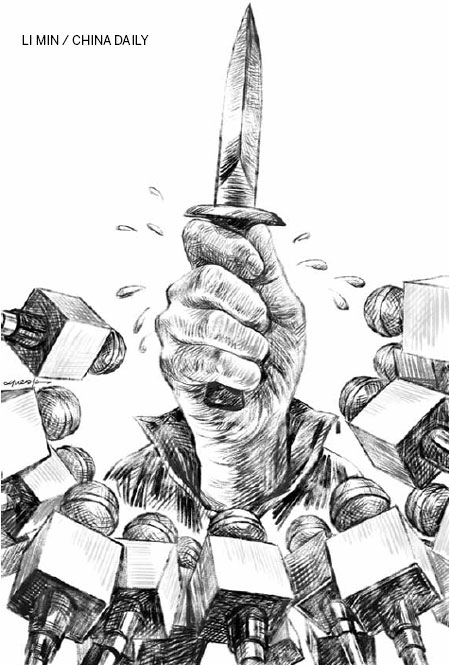 Russian navy ships make peace visit to Cuba
Russian navy ships make peace visit to Cuba
 Hong Kong Airlines stewardesses learn Wing Chun kung fu
Hong Kong Airlines stewardesses learn Wing Chun kung fu
 Old town Dali hosts int'l photography exhibition
Old town Dali hosts int'l photography exhibition
 Death toll rises to 29 in rain-related accidents across Pakistan
Death toll rises to 29 in rain-related accidents across Pakistan
 Chinese police rescue baby allegedly sold by doctor
Chinese police rescue baby allegedly sold by doctor
 Nutrica recalls Karicare infant formula in New Zealand
Nutrica recalls Karicare infant formula in New Zealand
 Sexy models in CFGP race
Sexy models in CFGP race
 Child labor still remains rampant in war-hit Afghanistan
Child labor still remains rampant in war-hit Afghanistan
 Sun Yang the star of last day at World Swimming Championships
Sun Yang the star of last day at World Swimming Championships
 |
| (China Daily) |
The recent spate of stabbings in China raises an interesting psychological question and media dilemma quite apart from the tragic events themselves. Has detailed media exposure of the crimes exacerbated the problem, resulting in copycat acts, thereby further disturbing social security? If so, does the media have a responsibility to report such incidents in a manner that mitigates the likelihood of the acts being repeated?
Before attempting to address the questions, there is an important caveat to consider: Have stabbings actually increased in China in recent weeks? That seems to have a self-evident answer, because the stabbings have been more in the news. But without a statistical breakdown, it is impossible to know whether stabbings or merely reports on them have increased.
For example, three years ago the media reported that there was an "epidemic" of suicides at the electronic company Foxconn. For months, the press reported each of the gruesome suicides in detail. A host of news reports appeared to suggest that the company was at fault and needed to change its policies. It turned out, however, that Foxconn's suicide rate during that particular reporting cycle was actually lower than China's national average based on the number of employees working at Foxconn.
If, after a thorough investigation, journalists discover that the stabbings in recent weeks have increased, then psychology may have a few answers as to why. But even those answers should be taken with a grain of salt, since it is always easier to offer ex post facto explanations for phenomenon than to predict future behaviors or events.
While it is not altogether clear why an individual will imitate another's criminal behavior, it is a well-established psychological principle that we do model our behavior according to what we see others doing.
Beginning with an ingenious experiment in 1961, Stanford University psychologist Albert Bandura helped social learning theorists recognize that individuals can learn merely by observing the behaviors of others.
In Bandura's Bobo doll experiment, children watched a television monitor in which adults punched and kicked a 5-foot plastic blow-up doll. When the children subsequently were in a room with the Bobo doll, they imitated the adults' aggressive behavior, thus providing evidence that learning occurs through modeling. Bandura also found that children who were not exposed to the aggressive model were unlikely to behave aggressively.
Similarly, the massive wave of emulation (copycat) suicides after a widely publicized suicide is known as the Werther effect, following Johann Wolfgang von Goethe's novel The Sorrows of Young Werther. The novel, in which the hero kills himself, was banned in some European countries after its publication more than 200 years ago because of a rash of suicides by young men who had read it.
While copycat suicides are not as common as feared, the existence of suicide clusters has been confirmed by studies launched by the Center for Disease Control and Prevention in Atlanta, Georgia, in the US.
But knowing that publication of anti-social events such as mass stabbings, airport bombings or celebrity suicides, compounds the problem, begs the question as to how the media should handle such events. Should the media turn a blind eye or attempt to put a positive spin on bad news?
 |
 Tough training of PLA special forces
Tough training of PLA special forces  Pakistan's rain-triggered accidents claim 29 lives: media
Pakistan's rain-triggered accidents claim 29 lives: media Strong tropical storm Jebi leaves Hainan
Strong tropical storm Jebi leaves Hainan Top 10 most dangerous jobs in the world
Top 10 most dangerous jobs in the world Yi people celebrate torch festival with songs and dances
Yi people celebrate torch festival with songs and dances  Sun Yang wins 3rd gold of World Championship
Sun Yang wins 3rd gold of World ChampionshipDay|Week|Month